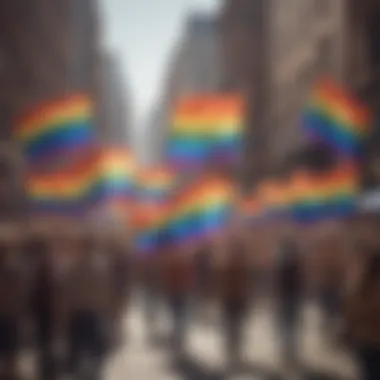Exploring Pride Flags: Symbols of Identity in Culture


Intro
Pride flags carry significant meaning in the LGBTQ+ community, serving as vital symbols of identity and representation. As society evolves, so does the array of flags that represent diverse identities. This overview explores the meanings behind different pride flags, their historical context, and their social significance. Understanding these flags helps illuminate the complexities within the LGBTQ+ community and celebrates its rich heritage.
The range of flags extends beyond just the well-known rainbow flag, encompassing various colors, patterns, and designs. Each flag tells a story and represents specific communities within the broader LGBTQ+ spectrum. With this backdrop, we can better appreciate the artistic expressions and social movements that have shaped these important symbols.
Though pride flags have become synonymous with celebration and visibility, they often reflect struggles, triumphs, and resilience. This article aims to provide a comprehensive understanding of pride flags in contemporary culture, appealing to diverse audiences seeking insight into these significant symbols.
Historical Context
The history of pride flags is deeply intertwined with LGBTQ+ rights movements. The rainbow flag, designed by Gilbert Baker in 1978, was the first to become globally recognized. Each color represents different values, with red symbolizing life and violet representing spirit. This flag became a beacon for the movement, promoting visibility and acceptance for LGBTQ+ individuals.
As the years progressed, many other flags emerged, each representing specific identities such as bisexual, transgender, and non-binary communities. This evolution illustrates an ongoing effort to embrace and celebrate diversity within the community.
Notable Pride Flags
- Rainbow Flag
The iconic symbol of LGBTQ+ pride, representing diversity and acceptance. - Transgender Flag
A blue and pink flag with a white stripe in the middle, this flag symbolizes the transgender community and their battles for recognition and rights. - Bisexual Flag
Featuring pink, lavender, and blue stripes, this flag represents the bisexual community and its unique identity.
These flags, among others, not only depict identity but also reflect activism, creating a sense of belonging among diverse communities.
"Pride flags are not just fabric; they are representations of lives, struggles, and victories of people within the LGBTQ+ community."
Epilogue
In summary, pride flags play a vital role in expressing identity and fostering community. Each flag has its own narrative, representing unique experiences within the LGBTQ+ spectrum. Their significance transcends mere design; they embody history, resilience, and cultural pride. Understanding these flags enriches our comprehension of contemporary LGBTQ+ culture and honors the ongoing quest for equality and recognition.
Intro to Pride Flags
Pride flags serve as powerful symbols of identity, community, and resistance within contemporary culture. They encapsulate various aspects of the LGBTQ+ experience and embody the ongoing journey towards equality and acceptance. Understanding pride flags is crucial for recognizing the diverse narratives and histories that these symbols represent.
These flags go beyond mere colors and patterns; they carry deep meanings and stories that resonate with individuals and communities. From the iconic rainbow flag to the multitude of identity-specific flags, each one is a statement of visibility and pride.
The exploration of pride flags allows us to engage with significant themes of representation, empowerment, and social justice. By uncovering the layers of identity embedded in these flags, we can appreciate the strides that the LGBTQ+ community has made, while also acknowledging the challenges that remain.
Through this article, we aim to deepen understanding and foster appreciation for the vibrant world of pride flags, highlighting their role in advocacy and cultural expression.
Defining Pride Flags
Pride flags are visual representations of specific identities within the LGBTQ+ community. Each flag features unique colors and patterns, reflecting the identity it represents. In essence, these flags act as markers of solidarity, allowing individuals to express their belonging to a particular group. The use of flags as symbols stems from the need for visibility in a society that often marginalizes or ignores LGBTQ+ individuals.
The most widely recognized pride flag is the rainbow flag, introduced in 1978 by Gilbert Baker. It serves to represent the broad spectrum of sexual orientations and gender identities. The colors in the rainbow flag are often interpreted to symbolize different aspects of life and humanity, encapsulating the rich tapestry of LGBTQ+ experiences.
Historical Context
The history of pride flags is closely aligned with the evolution of LGBTQ+ rights movements. In the late 20th century, as the gay rights movement gained momentum, the need for symbols that could unify and represent the community became evident. The rainbow flag was adopted not just as a tool of expression, but also as a rallying point for activism. Over time, various flags have emerged to recognize different sexual orientations and gender identities, contributing to an expanding lexicon of symbols within the LGBTQ+ community.
The flags have also evolved alongside societal changes. In recent decades, there has been a significant shift towards inclusivity and intersectionality, leading to the creation of flags that address specific identities, like transgender pride and non-binary pride flags. Understanding this historical context provides insight into the ongoing struggles for equality and the evolving nature of identity politics in society.
The Rainbow Flag: A Symbol of Diversity
The Rainbow Flag has become an emblem of unity and diversity within the LGBTQ+ community. Originating from a deep cultural need for representation, this flag symbolizes not just sexual orientation, but an array of identities and experiences that form the fabric of societal diversity. Understanding the Rainbow Flag’s origins and variations deepens appreciation for its role in contemporary culture.
Origins of the Rainbow Flag
The Rainbow Flag was first conceptualized in 1978 by artist Gilbert Baker in San Francisco. Baker was inspired to create a symbol that would encompass the diverse spectrum of human identities. The flag originally had eight colors, with each hue representing a specific meaning: pink for sexuality, red for life, orange for healing, yellow for sunlight, green for nature, turquoise for magic, indigo for serenity, and violet for spirit. However, operational challenges led to a simplified six-color version, which became the standard used in most pride events today.
The rise of the Rainbow Flag coincided with the growing visibility and activism surrounding LGBTQ+ rights. In the years following its introduction, it gained prominence as a powerful symbol of pride and resilience against adversity, largely during the AIDS crisis in the late 20th century. Its importance in rallies and celebrations cannot be overstated. The Rainbow Flag remains an icon, representing solidarity and acceptance within both the LGBTQ+ community and society at large.
Variations and Adaptations
The Rainbow Flag has undergone numerous modifications and adaptations over the years. These changes reflect the evolving conversations about identity, representation, and inclusivity within the LGBTQ+ community.
Modified Rainbow Flags
Modified Rainbow Flags have become increasingly popular as they address the need for inclusivity by including additional colors or symbols that represent other identities. For example, the addition of black and brown stripes in some flags highlights the experiences of LGBTQ+ people of color. This type of flag often seeks to broaden the spectrum of diversity acknowledged within the original design.
The key characteristic of Modified Rainbow Flags is their adaptability. They not only symbolize solidarity but also invite discussions about intersectionality within the LGBTQ+ movement. These adaptations can be a beneficial choice for events that emphasize unity or for specific communities wanting to assert their visibility. However, they also present challenges, particularly surrounding concerns that too many variations might dilute the central message of solidarity.
Regional Variants


Different regions have also created their own interpretations of the Rainbow Flag, leading to Regional Variants that reflect local cultures and issues. These flags often serve both decorative and representational purposes, aligning with community values or concerns specific to a geographic area.
The unique feature of Regional Variants is their cultural specificity. For instance, flags might incorporate local symbols or historical elements that resonate with the community, thus enhancing a sense of belonging and pride. They are popular because they allow groups to celebrate both their identity and heritage, fostering greater local engagement. On the downside, these variants can sometimes lead to confusion among those unfamiliar with their specific significance, underlining the importance of education about each flag's meaning in the wider context of LGBTQ+ representation.
The Rainbow Flag continues to evolve, reflecting ongoing societal changes and the fluidity of identity in contemporary culture.
Gender Identity Flags
Gender identity flags play a vital role in the broader landscape of pride flags as they specifically address identities beyond the traditional binary framework. They serve not only as symbols of recognition but also as means of fostering dialogue and understanding regarding gender diversity. These flags are essential for members of the LGBTQ+ community as they provide a sense of belonging and visibility. The colors and symbols embedded in these flags reflect various narratives and histories, marking the distinct experiences of individuals.
Transgender Pride Flag
The Transgender Pride Flag was created by Monica Helms in 1999. It features five horizontal stripes: two light blue, two pink, and one white in the center. The blue represents masculinity, and pink represents femininity, while the white stripe symbolizes those who are transitioning or identify outside the binary spectrum.
This flag works effectively to raise awareness of transgender issues and advocate for transgender rights. The design’s symmetry serves a purpose; it can be displayed in any orientation, symbolizing that no matter how one experiences their gender identity, the flag remains valid.
The importance of the Transgender Pride Flag cannot be understated. It creates visibility for a community that often faces discrimination and misunderstandings. As such, it has become a powerful symbol during pride marches and other advocacy events.
Non-Binary Pride Flag
The Non-Binary Pride Flag, designed by Kye Rowan in 2014, consists of four horizontal stripes: yellow, white, purple, and black. The yellow represents people whose gender exists outside the binary; white symbolizes those who are gender neutral or identify as having multiple genders. Purple reflects those who are a mix of both male and female genders, while black represents those who are agender.
This flag aims to broaden the understanding of gender and provide a sense of community for non-binary individuals. It is particularly significant as it challenges the conventional notions of gender, promoting acceptance and recognition of non-binary identities, which are often overlooked in broader societal discussions.
The introduction of gender identity flags has enabled more nuanced conversations regarding identity, highlighting the importance of visibility in advocacy efforts.
These flags not only symbolize resilience but also represent the ongoing journey towards acceptance and equality.
Sexual Orientation Flags
Sexual orientation flags serve as significant symbols within the LGBTQ+ community. They reflect diverse identities, fostering a sense of belonging and recognition. By encompassing various sexual orientations, these flags play a vital role in advocacy and awareness. They highlight the unique experiences and struggles faced by different groups, creating visibility in broader society.
The importance of sexual orientation flags can be seen in several key aspects. Firstly, they empower individuals to express their identities openly. Additionally, they serve as a unifying force within the LGBTQ+ community, promoting solidarity across different groups. Finally, these flags facilitate conversations around sexual orientation, encouraging understanding and respect among people of all backgrounds.
Lesbian Pride Flag
The Lesbian Pride Flag is a potent representation of lesbian identity. First introduced in 1999, it features a gradient of colors ranging from dark orange at the top to dark purple at the bottom. This flag aims to convey the diversity within lesbian identities. The colors symbolize different aspects of femininity and the lesbian experience, allowing a wide range of interpretations.
Over time, several variants of the lesbian flag have emerged, reflecting specific cultures and communities within the lesbian spectrum. The most notable variant is the lipstick lesbian flag, characterized by a bright pink, center stripe representing femininity and lipstick. This simple yet effective design resonates with many individuals identifying as part of the lesbian community.
Bisexual Pride Flag
The Bisexual Pride Flag was created in 1998 by Michael Page. The flag consists of three horizontal stripes, with a wide blue stripe on the top, a wide pink stripe on the bottom, and a narrower purple stripe in the middle. The blue represents attraction to those of the same sex, while pink symbolizes attraction to those of a different sex. Purple, in contrast, represents the intersection of the two.
This flag has become a fundamental aspect of bisexual visibility. It addresses the erasure of bisexual identities within the larger LGBTQ+ community. Thus, it plays an essential role in educating others about bisexuality, fostering a deeper understanding among both LGBTQ+ and non-LGBTQ+ populations.
Pansexual Pride Flag
The Pansexual Pride Flag emerged in 2010. It consists of three horizontal stripes: pink, yellow, and blue. The pink stripe represents attraction to females, the blue stripe signifies attraction to males, and the yellow stripe symbolizes attraction to non-binary individuals. This flag highlights the inclusive nature of pansexuality, which encompasses a broad spectrum of identities.
By using this flag, pansexual individuals assert their identities and highlight the complexities of attraction beyond the traditional binary framework. This flag encourages dialogue around the pansexual experience, making visible a community that often goes overlooked within discussions of sexual orientation.
"Sexual orientation flags are more than just symbols; they are emblems of pride, resistance, and recognition, resonating deeply with our collective struggles."
In summary, sexual orientation flags offer more than mere visual representation. They encapsulate rich histories and signify ongoing efforts for acceptance and equality. Understanding the Lesbian, Bisexual, and Pansexual flags becomes essential for appreciating the breadth of sexual identities and their place in contemporary culture.
Intersectionality in Pride Flags
The concept of intersectionality plays a significant role in understanding pride flags and their meanings in contemporary culture. It acknowledges that individuals have multiple identities that intersect, influencing their experiences and expressions within the LGBTQ+ community. This section aims to elucidate how intersectionality informs representation through pride flags. By examining different facets of identity, we can appreciate the diversity and richness within the LGBTQ+ spectrum.
Intersectionality also highlights the interconnections between various communities. For instance, the struggles faced by LGBTQ+ individuals who are also part of racial or cultural minority groups reveal layers of complexity that need acknowledgment. Pride flags representing these intersections foster a sense of belonging and allow unique narratives to be shared.
Understanding Intersectionality
Intersectionality, a term coined by Kimberlé Crenshaw, refers to how various identities—race, gender, sexuality, and class—interact to shape individual experiences. It is crucial to note that these overlapping identities can cause compounded discrimination or privilege. In the context of pride flags, intersectionality ensures that the flags do not solely represent singular aspects of identity, but instead, reflect the multifaceted experiences of individuals.
In today's advocacy, representing intersectionality goes beyond mere visibility; it aims to include voices often unheard. When designing or promoting pride flags, creators consider this approach for a more inclusive environment.
Intersectional Flags


Black LGBTQ+ Flag
The Black LGBTQ+ flag is a significant symbol that represents the unique experiences of Black individuals within the queer community. Its creation acknowledges the intersection of race and LGBTQ+ identity. This flag aims to highlight the historical and ongoing challenges faced by Black LGBTQ+ individuals, emphasizing the need for equality and justice in both racial and sexual orientation contexts.
One key characteristic of this flag is its use of pan-African colors—red, black, and green—alongside the traditional rainbow. This addition emphasizes the important connection to cultural identity while broadening the representation within the LGBTQ+ narrative.
The unique feature of the Black LGBTQ+ flag is its focus on dual advocacy. It is beneficial in generating awareness about issues like police violence against Black individuals and discrimination within the LGBTQ+ spaces themselves. However, it also faces challenges, such as potential dilution of focus on individual aspects of both identity and struggle.
Polyamorous Pride Flag
The Polyamorous Pride Flag addresses the needs of individuals in consensual non-monogamous relationships. It promotes visibility and acceptance not only for sexual diversity but also for different relationship structures. This flag typically features colors such as blue, red, and black with a heart symbol in the center, embodying the concept of love in multiple forms.
One notable characteristic of this flag is its emphasis on consent and communication within relationships. This focus highlights the values that underpin polyamorous structures, offering an alternative to traditional views around monogamy.
The Polyamorous Pride Flag serves as a beneficial symbol by advocating for inclusivity within the broader LGBTQ+ discussions. However, it also encounters challenges regarding recognition, often being less understood or accepted compared to more established flags.
The intersectional representation through flags allows marginalized voices to be heard, reflecting the diverse experiences within the LGBTQ+ spectrum.
Flags Representing Specific Communities
The representation of specific communities through pride flags is crucial in understanding the diverse spectrum of identities within the LGBTQ+ landscape. These flags serve as more than mere symbols; they embody the unique experiences, struggles, and achievements of each group. By displaying a flag specifically designed for their community, individuals affirm and celebrate their identities. This act of visibility fosters a sense of belonging and recognition within broader society.
Asexual Pride Flag
The Asexual Pride Flag, introduced in 2010, features four horizontal stripes: black, gray, white, and purple. The black stripe represents asexuality, while the gray stripe signifies graysexual and demisexual identities. The white stripe symbolizes non-asexual partners, and the purple stripe embodies community. This flag was created to promote awareness of asexual identities and the spectrum of experiences related to them. Asexuality is often misunderstood, and the flag represents an important tool for advocacy and education. It helps challenge misconceptions and fosters greater acceptance of these identities.
Intersex Pride Flag
The Intersex Pride Flag was launched in 2013 and features a yellow background with a purple circle in the center. This design is intentional; it was chosen to allow for visibility without adhering to traditional gender colors. The color scheme signifies wholeness and completeness. Intersex individuals often face stigma and discrimination, but this flag acts as a unifying symbol for the intersex community. It emphasizes the importance of inclusion and respect for bodily autonomy. The flag serves as a call for understanding and a recognition of the unique challenges intersex people navigate.
Two-Spirit Flag
The Two-Spirit Flag is a contemporary symbol representing Two-Spirit identities among Indigenous peoples in North America. It often incorporates elements from both Indigenous culture and LGBTQ+ symbolism. The flag varies in design and is sometimes seen with a rainbow background complemented by Indigenous motifs. The term Two-Spirit itself is complex and encompasses a range of gender identities and expressions. This flag recognizes the historical and cultural significance of Two-Spirit individuals in Indigenous communities. It seeks to honor ancestral traditions while asserting modern identity.
"Pride flags representing specific communities are not just emblems; they signify the persistent struggle for recognition and respect."
The significance of flag representation extends beyond visibility. These flags serve as critical platforms for dialogue and education about the intricacies of identity. Their existence contributes to a broader understanding of the diversity within LGBTQ+ identities, further promoting inclusivity and acceptance.
Evolution of Pride Flags
The evolution of pride flags reflects the broader changes within the LGBTQ+ community. This topic is essential to understanding how these symbols have become beacons of identity, representation, and advocacy. As societies have evolved, so too have the flags that represent LGBTQ+ identities. Not only do these flags convey particular meanings, but they also adapt to the growing complexity of identities and experiences found within the community.
Key elements of this evolution include the shifting societal attitudes toward gender and sexuality, new forms of activism, and cultural influences that shape identity. Understanding these elements allows one to appreciate the rich heritage and ongoing dialogues surrounding pride flags. Benefits of studying this evolution include recognizing the importance of visibility and representation in social movements and the role that flags play as unifying symbols.
Historical Changes
Throughout history, the concept of pride flags has undergone significant transformations. Early LGBTQ+ movements did not have distinctive flags but rather relied on symbols such as the pink triangle, a symbol that originated during World War II as a badge for homosexuals in Nazi Germany.
The introduction of the Rainbow Flag in 1978, designed by Gilbert Baker, marked a significant milestone. Its multi-colored stripes symbolized diversity and inclusiveness. Over time, additional colors and designs were incorporated, enhancing the flag's meaning further.
Various communities began to adopt their own flags, each reflecting unique aspects of their identities. For example, the transgender pride flag, created in 1999 by Monica Helms, features blue and pink stripes that represent the binary gender identities, alongside white for those who are non-binary or transitioning.
Contemporary Trends
In more recent years, the landscape of pride flags has expanded even further. There are now numerous variations, each designed to represent different facets of individual and collective identity within the LGBTQ+ community.
One notable trend is the increasing focus on intersectionality. New flags, such as the Progressive Pride Flag, incorporate elements to acknowledge the experiences of marginalized groups within the LGBTQ+ sphere. This flag includes a black and brown stripe to represent LGBTQ+ people of color, addressing historical omissions in representation.
The rise of social media has also played a critical role in the spread and adoption of pride flags. Online platforms allow communities to share images and stories related to their identities, leading to greater visibility and awareness.
The Role of Pride Flags in Advocacy
Pride flags serve a multifaceted role in the realm of advocacy, acting as powerful visual symbols that communicate messages of identity, resistance, and solidarity. In a world where marginalized voices often struggle for recognition, these flags transcend mere fabric. They encapsulate the stories and struggles of diverse communities within the LGBTQ+ spectrum. Understanding their role in advocacy highlights not only their historical significance but also their continuing relevance in contemporary culture.
Flags as Tools of Protest
Throughout history, flags have been used as tools of protest, rallying individuals around common causes. Pride flags embody this spirit of dissent and empowerment, particularly during significant social movements. For example, the Rainbow Flag, designed by Gilbert Baker in 1978, became a universal symbol for LGBTQ+ pride and resistance against oppression.
- Symbolic Representation: Each color in the Rainbow Flag represents a different aspect of the LGBTQ+ community, emphasizing diversity and inclusivity.
- Rallying Points: During events such as Pride Month and various protests, these flags act as visual rallying points, fostering unity and solidarity.
- Historical Backdrop: The use of flags during protests against discriminatory legislation serves to highlight ongoing struggles for equality and rights


Advocacy groups often incorporate pride flags into their campaigns. This practice not only raises awareness but also challenges societal norms by creating a visible presence of underrepresented identities. By waving these flags in public demonstrations, activists seek to elevate dialogue around critical issues like marriage equality, workplace discrimination, and trans rights.
Visibility Through Symbols
Visibility is a core element in any advocacy effort. The presence of pride flags in different spaces promotes awareness and acceptance of LGBTQ+ issues among broader audiences. When community members carry these symbols in parades, community events, or even everyday life, they normalize LGBTQ+ identities.
- Cultural Conversations: Flags can initiate conversations about identity and representation, effectively breaking down barriers of misunderstanding.
- Allyship: Allies showing support by displaying pride flags contribute to the ongoing fight for equal rights, thus helping to create an environment where all identities can flourish.
- Intersectional Visibility: In recent years, additional flags representing specific identities, like transgender or non-binary flags, have emerged. These additions offer more inclusive visibility, acknowledging the varied experiences within the LGBTQ+ community.
"The presence of pride flags in public spaces not only affirms identity but also serves as a beacon of hope for those who feel marginalized."
Controversies and Debates
The topic of controversies and debates surrounding pride flags holds considerable significance within the context of contemporary LGBTQ+ culture. These discussions unveil various perspectives that contribute to how identity and representation are perceived. The symbols, while often celebrated for their role in advocacy, can also trigger discussions concerning inclusivity and cultural sensitivity. It is crucial to understand these debates to appreciate the evolving landscape of the LGBTQ+ community fully.
The Challenge of Inclusivity
Inclusivity remains a complex challenge for pride flags. A central theme in discussions about these symbols is their ability to represent the vast spectrum of identities. The initial rainbow flag served as a universal symbol for the LGBTQ+ community. Yet, as more groups seek acknowledgment, the question arises: can one flag truly represent everyone?
This issue is further complicated by the emergence of various flags that denote specific identities, such as the Transgender Pride Flag or the Bisexual Pride Flag. While these flags enhance visibility for their respective groups, they may also create a sense of division within the larger community. Some individuals argue that diversifying representation leads to fragmentation rather than unity.
"The pursuit of inclusivity must be balanced with the need for unity, creating a foundation where everyone feels represented."
Cultural Appropriation and Flags
Cultural appropriation is another focal point of debate when it comes to pride flags. As pride flags gain mainstream visibility, there are concerns about their appropriation by those outside the LGBTQ+ community. The authentic meanings and histories of these symbols can risk being overshadowed by commercial interests or misinterpretation.
For instance, rainbow merchandise often appears in various contexts, sometimes dissociated from their original significance. This phenomenon raises questions regarding the responsibilities of individuals and corporations in understanding and respecting the cultural roots of these symbols. In some cases, it may lead to commodification rather than genuine support for the LGBTQ+ community.
Establishing a dialogue about cultural appropriation can serve as a way to reinforce the importance of respecting how these flags function within the community they represent. Understanding the narratives behind each flag contributes to a richer appreciation of their meanings and ensures that multicultural representations remain purposeful and relevant.
Pride Flags Beyond the LGBTQ+ Community
The discussion of pride flags often centers on representations specific to the LGBTQ+ community. However, recognizing pride flags beyond this framework is crucial. These flags serve as broader symbols, capturing the complexities of human identity. They reflect the rich tapestry of personal experiences, cultures, and alliances that intersect with traditional identities. By expanding our view, we appreciate how various groups utilize flags to express solidarity and acknowledgment of their unique struggles and histories.
Broader Representation of Identity
Pride flags have evolved. They now symbolize not only sexual orientation and gender identity, but also political stances and cultural movements. Broader representation encourages inclusivity. This inclusivity fosters a greater understanding of diverse communities. For instance, flags representing indigenous cultures or social justice can provide a voice to marginalized groups, illustrating collective identity and shared hopes. These flags challenge the norms of communication, creating spaces for dialogue centered around respect and acceptance.
Some examples of flags representing broader identities include:
- Black Lives Matter Flag: This flag showcases the struggle against racial injustice and emphasizes the importance of black voices in the LGBTQ+ movement.
- Transracial Flags: Various flags arise from conversations around identity, highlighting individual experiences in multiracial societies.
Flags in Global Context
Flags in a global context illustrate the wide-ranging nature of pride and activism. Different cultures employ distinct flags, each carrying its own significance. For example, in various African nations, pride flags represent local LGBTQ+ movements often faced with stringent societal norms. Conversely, in Western countries, flags may encourage more overt expressions of identity and pride.
Understanding these differences is essential for grasping the full picture of global identity politics. International movements advocate for LGBTQ+ rights in diverse cultural climates. Flags become a unifying symbol, transcending borders and inspiring solidarity.
"In many cultures, flags act as a beacon of hope, illustrating shared narratives and aspirations."
Future of Pride Flags
The future of pride flags holds significant implications for representation and identity within the LGBTQ+ community. As society evolves and new identities emerge, the symbols that represent these identities also necessitate change. The ongoing discourse surrounding gender and sexual orientation calls for flags that can adapt and reflect the shifting landscape of societal norms and values.
In considering the future of pride flags, one must acknowledge the importance of inclusivity. Pride flags must not just serve the established categories of sexual orientation or gender identity but also encompass those who do not fit into traditional frameworks. This enhances visibility for multifaceted identities often overlooked in mainstream discussions.
Furthermore, new technological advancements have ushered in a digital era where symbols can be fluid and mutable. Online platforms encourage the creation of new flags through collaborative art or design initiatives, leading to a rich tapestry of representation that is both democratic and inclusive. Emerging symbols will likely resonate with contemporary values around expression and community acknowledgment, thereby strengthening their place in the ongoing narrative of pride.
"Flags that adapt over time can better resonate with evolving identities, making them more relevant in future social movements."
The evolution of pride flags will also pivot towards intersectionality. Recognizing the multilayered nature of identity can lead to designs that are not only visually appealing but also intellectually and emotionally resonant. Future pride flags may integrate elements from various cultures and communities, allowing them to articulate shared values while highlighting unique lived experiences.
Emerging Symbols
Emerging symbols are pivotal in weaving the narrative of changing identities. These symbols often encapsulate the aspirations and experiences of youth within the LGBTQ+ community. For instance, newer flags may emerge to represent bisexual people of color or non-binary individuals from diverse backgrounds. This is not merely about aesthetic changes but also reflects a deeper cultural acknowledgment of intersectionality and shared struggles.
The introduction of animated or digital flags may also come into play. These flags can change colors, patterns, or symbols based on user interaction or community votes, promoting a sense of agency and belonging to the individuals who choose to adopt them. The potential for engaging new generations through innovative expressions is significant.
Continued Evolution in Design
Designs of pride flags are likely to continue evolving as artists and activists push the boundaries of visual representation. Current trends suggest a movement towards minimalism and abstraction, enhancing the flags' meanings and interpretations. Simple stripes or symbolic patterns may invoke deeper cultural narratives, allowing for personal connection while maintaining broader community significance.
Moreover, the integration of eco-friendly materials in flag production is becoming more important. As awareness of sustainability issues rises, many in the LGBTQ+ community are advocating for flags made from recycled or ethically sourced materials. This trend not only promotes environmental consciousness but also aligns with the values of many within the movement.
In summary, the future of pride flags will encompass the emergence of new symbols and a continued focus on innovative and sustainable designs. This dynamic interplay reflects the nuanced understanding of identity that characterizes contemporary culture. By embracing change, pride flags can remain relevant and continue to foster inclusion and visibility for all members of the LGBTQ+ community.

